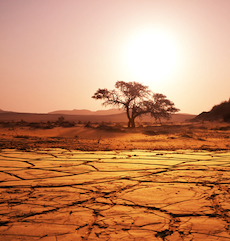A megadrought is a prolonged drought that spans multiple decades, causing widespread shortages in freshwater resources. The following facts and statistics provide insight into this long-term natural disaster that results a significant impact on water supplies and agriculture.
 NASA scientists predict that there is an 80 percent chance of a megadrought in the Southwest United States before the end of the century.
NASA scientists predict that there is an 80 percent chance of a megadrought in the Southwest United States before the end of the century.
Source
If emissions are reduced, the probability of a megadrought in the Great Plains by the end of the century will drop to an estimated 60-70%.
Source
A once thriving settlement by the Pueblo peoples in Chaco Canyon, New Mexico was abandoned in the 13th century due to a 60-year megadrought.
Source
In the past 1,200 years California has experienced two megadroughts that lasted up to 200 years.
Source
California’s climate was unusually wet in the 20th century compared to previous centuries.
Source
If carbon emissions don’t start declining by 2050, the risk of a decade-long drought in the Southwest and Central Plains doubles in the second half of the century.
Source
NASA scientists predict that a megadrought could occur as early as 2050.
Source
A single El Niño weather pattern in the West could interrupt periods of prolonged drought.
Source
The African Sahel region has experienced a megadrought every every 30 to 60 years with an extended megadrought from 1400 to 1750.
Source
A 300-year drought starting about 4,200 years ago was linked to the collapse of the Akkadians in Mesopotamia, the world’s first great empire.
Source
For comparison, the 1930s Dust Bowl in the Midwest, considered America’s worst drought in the 20th century, lasted just four to eight years in some areas.
Source
